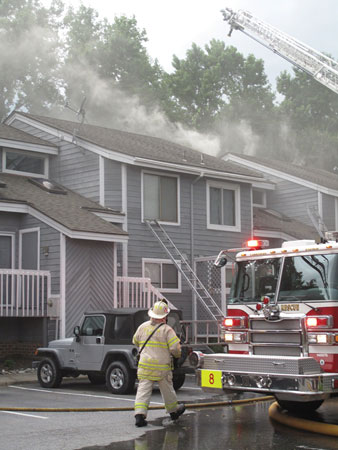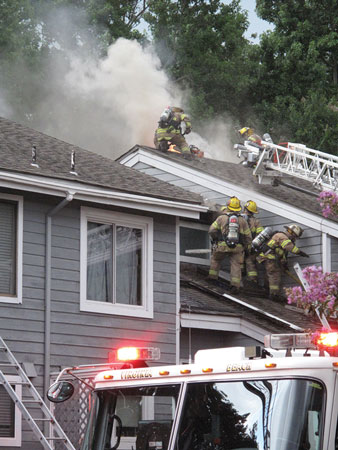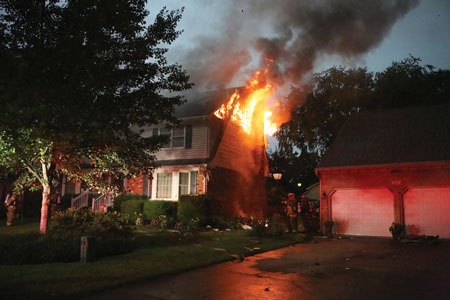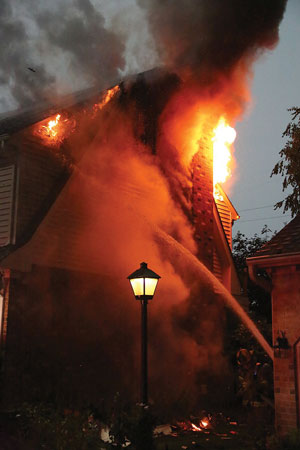
By MICHAEL J. BARAKEY
On March 29, 2016, three Boca Raton, Florida, firefighters were injured after lightning struck near them while working a house fire that was ignited by lightning.1 “They were bending over to bring the water hose from the back of the house to the truck, and that’s all they remember,” recalls Boca Raton Fire Rescue Public Information Officer Mike Lasalle. “We’re not sure if it hit them or the ground first; but, in my opinion, it must have hit near them. Direct hits usually end badly.” Two of the firefighters’ injuries were considered minor, Lasalle says, but the third firefighter was treated for more serious injuries at a local hospital. (1)
 |
| (1) The first-arriving officer transmitted a “working fire” with smoke and fire showing from the roofline. (Photos 1-4 by author.) |
Lightning strikes cause many fires in the United States every year. During the period from 2007 to 2011, U.S. fire departments responded to an annual average of 22,600 fires started by lightning.2 During this time period, 4,300 of the fires were classified as home structural fires. Although home structural fires were only 19 percent of the total fires, they were responsible for 86 percent of the civilian fire deaths, 76 percent of the civilian fire injuries, and 68 percent of the direct property damage. (2) From 2003 to 2013, four of the 42 firefighters who died as a result of a fire caused by lightning were operating at structure fires. The other 38 died on wildland fires. (2) The National Weather Service reports that from 2008 to 2012, an average of 29 people died per year from lightning strikes.3
Response to Structural Fires Started by Lightning
The Virginia Beach (VA) Fire Department (VBFD) does not alter the response to structure fires caused by a lightning strike. The duty shift commander or an operational battalion chief can place the city on a “modified” response because of severe weather. This modification is made because of the increase in call volume (lightning strikes, structural fires, alarm activations, wires down, service calls, and so on) that accompanies the severe weather event. The modification reduces the response to all incidents to one apparatus (engine, ladder, or rescue) unless smoke or fire is reported. If smoke or fire is reported during the 911 call, the fire dispatcher will send the normal assignment for the type of structure on fire.
 |
| (2) As the fire attack was initiated from the interior, the smoke conditions continued to indicate the fire was spreading horizontally to exposure attics. |
Fireground strategies, tactics, and tasks are not modified by policy during a lightning storm. The incident commander (IC) and the safety officer may modify fireground strategies, tactics, and tasks based on the severity of the lightning storm. This is situational and depends on the event.
Actual Fires
Condominium fire. In the afternoon of July 15, 2016, a thunderstorm developed over the oceanfront. At 1749 hours, the VBFD responded to a reported condominium fire. The first-due battalion chief and engine and ladder companies were working an elevator emergency resulting from a power outage caused by the storm. Because the storm developed quickly over the oceanfront, the VBFD was not on modified response. As the call was placed to 911, a police officer arrived and notified the dispatcher that smoke and fire, caused by a lightning strike, were visible from a condominium complex. The initial assignment was a battalion chief, four engines, two ladders, and a rescue company.
The first-arriving officer transmitted a working fire and confirmed smoke and fire showing from the roofline (photo 1).
 |
| (3) Ladder companies access the roof by ground ladder and aerial ladder. |
Heavy lightning had already passed through the area, but additional storms were building, and lightning could be seen in the distance. The first-arriving engine company stretched a 1¾-inch handline through the front door and advanced the line to the second floor to attack and contain the fire to the attic space of origin. Primary searches in the fire unit were completed, and additional companies with handlines were placed in the Bravo and Delta exposures as the fire was spreading through the different elevations of the common attic space. The engine companies attacked the fire in the condominiums by pulling ceilings and accessing the fire from below. The ladder companies searched four units and were then ordered to the roof to access the soffits and open the roofs as the fire progressed to the exposure attic spaces. The ladder companies used ground ladders and a straight-tip aerial ladder to gain access to the roofs (photos 2-4).
The incident commander considered the risk of placing the crews on the roof with lightning in the area. Without question, working a fireground alone is dangerous enough when lightning is in the area. Placing crews on roofs and ascending, placing, and descending ground and aerial ladders during lightning storms compound the danger.
 |
| (4) Access to the fire was gained through the soffit and ridge. |
House fire. On July 19, 2016, lightning ignited a house fire in Virginia Beach (photo 5). Just prior to the call’s being dispatched, a citizen pulled up at the fire station to report a house on fire down the street. A battalion chief, four engines, and a ladder company were dispatched for a reported house fire with multiple calls citing fire visible. As crews arrived, they observed heavy fire showing from the attic space on the Charlie/Delta corner (photo 6).
The lightning struck the masonry chimney, which ignited the attic space. The fire was well progressed when the initial crews arrived. The first-arriving engine initiated an interior attack with a 1¾-inch handline. As the line was being advanced to the second floor, a primary search was conducted on the first and second floors. The engine and ladder companies pulled ceilings to gain access to the fire in the attic.
![(5) Lightning struck a home’s chimney, and the attic quickly became involved in fire. <i>[Photos 5-9 by Rayford Smith, Virginia Beach (VA) Fire Department Multi-Media Unit.] </i>](https://emberly.fireengineering.com/wp-content/uploads/2017/02/1702FE_Barakey_Photo_5.jpg) |
| (5) Lightning struck a home’s chimney, and the attic quickly became involved in fire. [Photos 5-9 by Rayford Smith, Virginia Beach (VA) Fire Department Multi-Media Unit.] |
With lightning still in the immediate area, the IC and the safety officer considered the best way to access the fire, stop the horizontal fire spread, and preserve the unburned attic spaces. The aerial operator raised the aerial ladder in anticipation of possibly needing to use the master stream or to access the roof (photo 7).
Interior crews experienced access problems from below the fire because plywood decking was stored in the attic. As interior crews used the attic pull-down and worked to hook the ceilings close to the corners of the rooms to allow better access to the fire, the IC ordered a transitional attack to darken down the fire from a large second-story deck just off the master bedroom on the Charlie side and from a handline from the ground on the Delta side (photo 8).
 |
| (6) Fire was visible from the Charlie/Delta corner and progressing toward the Alpha side. |
During the initial stages of the firefight, the IC remained vigilant since the lightning storm was extremely active. The IC considered the safety of the crews when using ground ladders for overhaul.
Considerations on the Fireground
ICs and company officers need to respect the weather conditions while operating on the fireground. Throwing ground ladders, raising aerial ladders, performing rooftop operations, and working around trees are dangerous during the storm. In the condominium fire, VBFD crews needed to ventilate the roof and open the soffits to prevent the fire from continuing to spread to additional units. The work by the ladder companies allowed the fire to be extinguished without further spread to unburned exposures, but the IC never lost focus of the weather conditions. Once the exterior work was completed, the firefighters were immediately ordered off the roof and to bed the aerial ladder.
 |
| (7) Ground ladders and the aerial ladder were placed for access and possible use of the master stream. |
At the house fire, once the fire was darkened down and interior crews were able to gain access to the attic space through the pull-down scuttle and by opening ceilings, the IC ordered the aerial ladder to be bedded (photo 9).
Recommendations for Working with Lightning in the Area
Following are some recommendations for working as safely as possible when lightning is in the area:
- Preplan and watch the weather as storms are forecast for the area. Maintain situational awareness of storms as they build, and go over strategies and tactics with companies prior to the event.
- Assign the safety officer to watch the storm as it progresses as crews perform fireground activities. The IC needs to be made aware of potential safety issues on the fireground. At the house fire, the chimney was struck and damaged. This caused the chimney to be weakened. With an active storm in the area, the first-arriving officer noticed the potential for the collapse during his walk-around, and the safety officer placed fire line tape around the area to identify a potential hazard to additional crews.
- Identify safe locations for crews working on the fireground. The cab of the fire apparatus is a safe place. The interiors of the buildings (neighbors’ garages or exposures not affected by the fire) are also safe places for crews.
- If companies are ordered to the roof or asked to place ground ladders during the fire, once the task or objective is completed, have the crews descend the roof and bed the aerial ladder.
- Consider performing a transitional attack to darken down the advancing fire. Avoid having crews work under or near large trees. Once the transitional attack is completed, have crews retreat to a shelter or safer location to observe fire conditions.
- Consider developing policies or procedures for severe weather events. Determine how your department could alter or modify strategies, tactics, and tasks from traditional fireground operations when lightning is in the area.
 |
| (8) The incident commander ordered a transitional attack as interior crews hooked ceilings to gain access to the attic from below. |
References
1. https://weather.com/storms/severe/news/severe-weather-impacts-mar29.
2. Marty Ahrens, National Fire Protection Association, Fire Analysis and Research Division. Jan. 2008. “Lightning Fire s and Lightning Strikes.” http://watchungnj.gov/fire-safety/Lightning_Fires.pdf.
3. http://www.lightningsafety.noaa.gov/fatalities.shtml.
MICHAEL J. BARAKEY (CFO) has been in the fire service since 1993. He is the district chief of administrative services with the Virginia Beach (VA) Fire Department and oversees communications and information technology, finances and budget, resource management, research and analysis, and accreditation. He was previously assigned as the B-shift commander, the chief of personnel and development, and the chief of training. He is a hazmat specialist, an instructor III, a nationally registered paramedic, and a neonatal/pediatric critical care paramedic for the Children’s Hospital of the King’s Daughters in Norfolk, V irginia. Barakey is a planning team manager for the VA-TF2 US&R team and an exercise design/controller for Spec Rescue International. He has a master’s degree in public administration from Old Dominion University in Norfolk and graduated from the National Fire Academy’s Executive Fire Officer Program in 2009. He regularly contributes to Fire Engineering and is an FDIC classroom instructor.
 |
| (9) Once the fire was knocked down, the aerial ladder was stowed, and ground ladders were placed flat on the ground. |
Developing Guidelines for Lightning Safety for Firefighters
STRUCK BY LIGHTNING AN INVESTIGATION
Fire Engineering Archives

